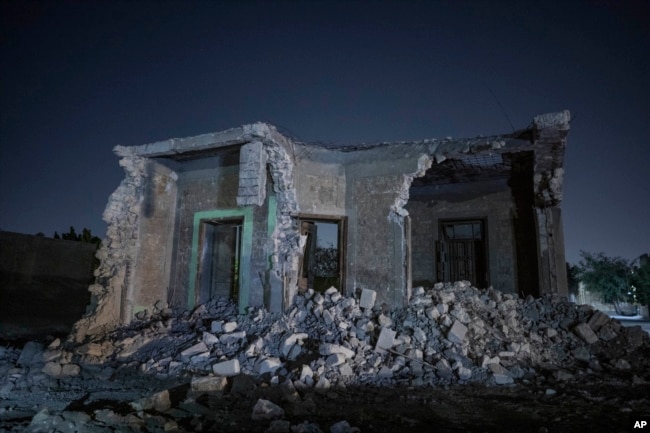For hundreds of years, Egyptian rulers, religious leaders, educators, and commoners have been buried in two large cemeteries in Cairo. These cemeteries together make an historic city of the dead.
Now the government is building highways through the burial grounds as part of a campaign to reshape Egypt’s capital. The project is creating concern among preservationists and some people living in the area.
In the Northern Cemetery, construction equipment recently destroyed the walls of some tombs to widen a road for the new highway. The tombs are from the early 20th century. They include the final resting places of well-known writers and politicians.
A 500-year-old tomb lies in the path of work crews. Although the tomb will remain standing, it will likely be surrounded on either side by the highway.
In the older Southern Cemetery, workers recently removed several hundred graves and built a huge flyover bridge. Nearby sits the tomb of one of Egypt’s first leading Islamic clergymen, Imam Leith.
As workers operated the equipment, families hurried to move the bodies of their loved ones. Other people faced losing their homes. Although known as the City of the Dead, the cemeteries are also communities, with people living in the walled areas that surround each grave.

Construction work on a highway flyover in a portion cleared of graves in the City of Dead in Cairo, Egypt, Sunday, July 26, 2020. The overpass cuts through the Southern Cemetery.
Cairo’s government and the Supreme Council of Antiquities noted that no registered monuments were harmed in the building process.
Mostafa al-Waziri is the head of the council. He told Egyptian television it was “impossible” that the council would permit the destruction of objects from ancient times. He added that the affected tombs are from the 1920s and 1940s, and belong to people or families who will get money from the government.
But some antiquities experts are concerned about Cairo’s history. Among the destroyed graves are many that have historical value, although they may not be on an official list of monuments.
Critics of the highway say it will destroy an environment that has survived largely unchanged for centuries.
May al-Ibrashy heads the Mugawara Built Environment Collective and has worked a lot in the Southern Cemetery. Al-Ibrashy described the cemeteries as an important “part of the history of Cairo” since its beginning.
Government campaign to modernize the country
In Cairo and other places around Egypt, the government has carried out a campaign of bridge and road building. Officials say they are needed to ease traffic and better connect different areas.
Critics say the building projects, at times, have no concern for the neighborhoods that they pass through. In some cases, flower gardens and greenery have been taken down to build bridges. One flyover bridge was built with almost the same width of the street it runs down. People who live there can step out of their upper-story windows onto the road.

A building stands partially demolished after bulldozers cleared the way for construction of a multilane freeway through the Northern Cemetery, part of the historic City of the Dead, a UNESCO World Heritage Site in Cairo, Egypt, Sunday, July 26, 2020. (AP Photo)
The two cemeteries, each at least 3 kilometers long, stretch north and south outside of Cairo’s Old City. The Northern Cemetery first began to be used by wealthy people in the 1300s and 1400s. The southern cemetery, known as al-Qarafa, is even older. It has been used since the 700s, not long after the Muslim conquest of Egypt.
“The thing about the cemetery is there’s a lot of hidden gems that no one knows about,” al-Ibrashy said. Al-Ibrashy explained that some of the graves date back to Ottoman rule. Some structures only look modern; they are probably much older because their names appear in “ancient guidebooks,” al-Ibrashy added.
“I’ve lived here for 41 years, I married my husband here,” said a woman in her 60s. She lived at a mausoleum that belonged to a prime minister from the early 20th century.
The old stone structure was saved, but work crews and their machines destroyed some of its nearby walls and rooms that served as her home. Her husband’s family members were the tomb’s guardians, and he was born and raised there.
“We have a long connection to this place. They don’t respect the living or the dead,” she said.
Dina Bakhoum is an art historian. She said that in recent years some government officials have started to believe in saving historic areas, not just monuments. The problem is, two or more government agencies decide what happens in Cairo, and decisions are sometimes made without any public discussion.
Bakhoum said, “I think the real problem we have here is really how do we define what is heritage, what is valuable, and for whom.”
Words in This Story
cemetery – n. a place where dead people are buried
highway – n. a major roadway
preservationist – n. someone who actively supports the protection of something, such as historic buildings
tomb – n. a building or above or below the ground in which a dead body is kept
grave – n. a hole in the ground for burying a dead body
antiquities – n. very old structures or objects
monument – n. a building or place that is important because of when it was built or because of something in history that happened there
conquest – n. the action of gaining control and occupying a place
gem – n. something that is admired for its beauty or excellence
heritage – n. the traditions or beliefs that are part of the history of a group or nation — usually singular